Phacelias start their springtime display by uncoiling their curved racemes with flowers of blue, mauve, purple or lavender. As their eye-catching, bell-shaped flowers open, these annuals call pollinators for a yummy meal of nectar and pollen. The high nutritive value of phacelias for pollinators guarantees that these annuals are coveted by both beekeepers and wildlife gardeners.
There are many sun-loving species of phacelias — including both annuals and perennials; the five annuals profiled here are easy to grow and are available from seed suppliers and nurseries.
Caution: The hairs on the stems and leaves may produce dermatitis in those who are sensitive. Wear long sleeves and gloves when working near phacelias.
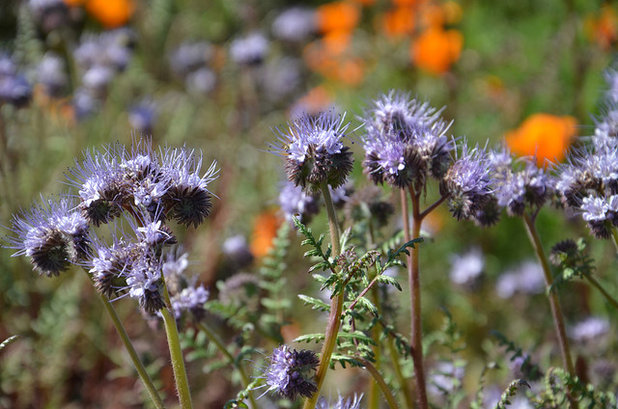
Pete Veilleux, East Bay Wilds
Botanical name: Phacelia spp
Common name: Phacelia
Origin: All are native to California; some species are also native to other states.
Where it will grow: Hardiness varies by species (USDA zones 3 to 10; find your zone)
Shown: P. tanacetifolia
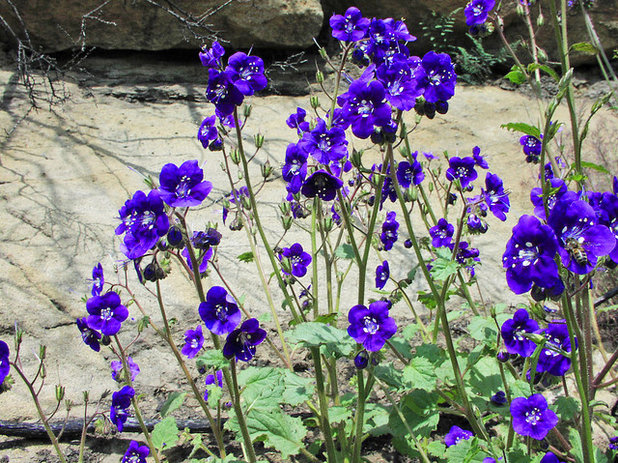 Water requirement:
Water requirement: Drought tolerant to moderate water
Light requirement: All species prefer full sun;
P. tanacetifolia tolerates light shade
Soil: Well drained
Shown: P. parryiPhoto by the National Park Service
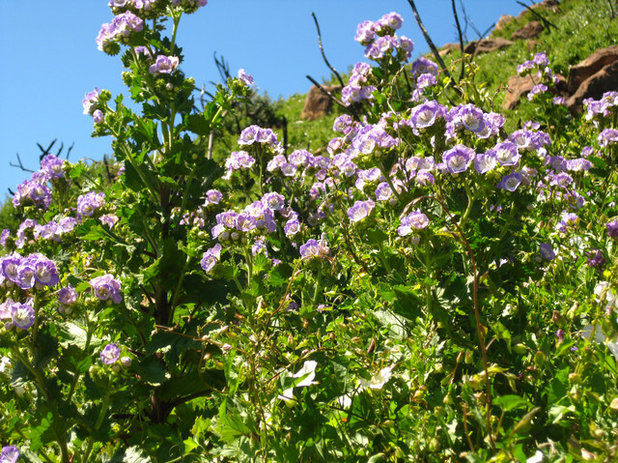 Benefits and tolerances:
Benefits and tolerances: Offers both pollen and nectar to pollinators; self-sows; deer resistant
Seasonal interest: Showy spring bloom
When to plant: Sow seeds in fall or early winter; put in plants from fall to early spring.
Shown: P. grandifloraPhoto by MzPrint
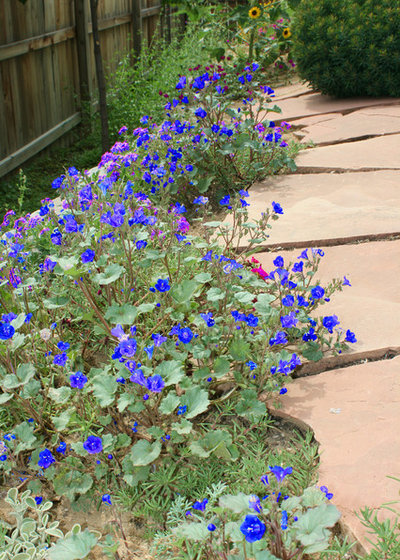 Distinguishing traits.
Distinguishing traits. Annuals with coiled racemes bloom in lovely shades of blue to purple in spring. They are easy to cultivate in gardens.
How to use it. The shorter species work well in rock gardens. All species can be massed or used in dry mixed beds.
Wildlife value. All phacelia species offer both nectar and pollen, making them highly attractive to native bees, honeybees and other pollinators. Phacelias are also a great nectar source for butterflies and a great seed source for birds.
Planting notes. All of these annual species reseed. Collect the seeds once they are mature, or let the seeds naturally self-sow. Fall is the ideal time for sowing seeds or putting in plants. In temperate regions plants can tolerate being planted in winter to early spring.
Shown: P. campanulariaPhoto by Patrick Standish
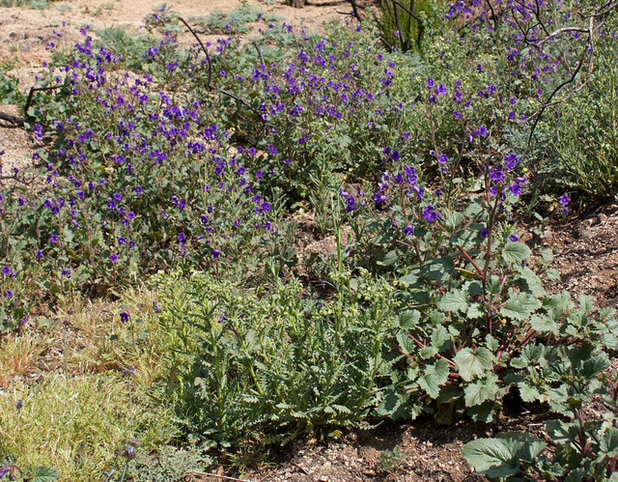
Whether planted in small groups or large masses,
P. campanularia,
P. minor and
P. parryi have blooms in deep blues and purples. They are breathtaking combined with plants with orange or yellow flowers that bloom at the same time and have the same cultural needs, like California poppy (
Eschscholzia californica) and tidy tips (
Layia platyglossa).
P. grandiflora lends a touch of royalty with its lavender-colored, open bell-shaped flowers and charming scent of grape candy.
And
P. tanacetifolia produces some of the highest-quality food for pollinators while contributing textural caterpillar-like fiddleheads to the spring ecstasy. More on the merits of each species follows.
Shown: P. MinorPhoto by Laura Camp
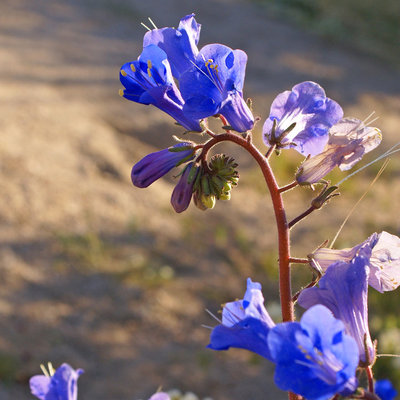
Debbie Ballentine
Desert Canterbury Bells(
Phacelia campanularia)
Native to Arizona and California
Native range: Coast, desert and inland
Where it will grow: Hardy to -40 degrees Fahrenheit (USDA zones 3 to 10)
P. campanularia is a desert wildflower that thrives in gardens and is one of my all-time favorites. Its brilliant blue flowers are stunning, whether the plant is massed or intermixed with other plants. Provide good drainage, and this annual will perform well. Expect
P. campanularia to grow 1 foot to 2 feet tall and 2 feet wide.
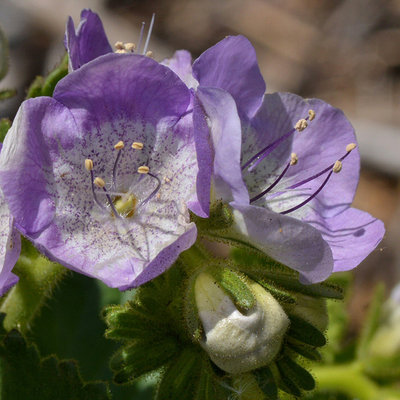
Treebeard
Largeflower Phacelia(
Phacelia grandiflora)
Native to California
Native range: Coast, inland; grows to higher elevations (5,000 to 7,500 feet)
Where it will grow: Hardy to -20 degrees Fahrenheit (USDA zones 5 to 10)
Although from higher elevations,
P. grandiflora is nearly effortless to grow in home gardens. Exuberant grape-scented flowers bloom best in soil with a bit of compost.
P. grandiflora will grow up to 3 feet tall and 16 to 36 inches wide. Use it in a mixed border or massed with plants of similar size.
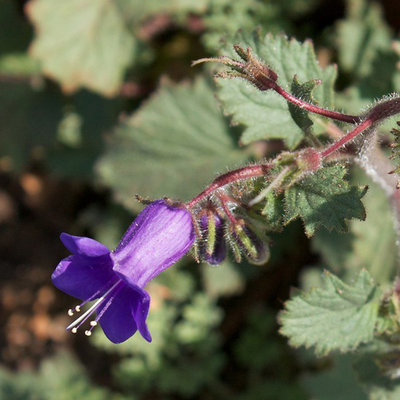 Wild Canterbury Bells
Wild Canterbury Bells(
Phacelia minor)
Native to California
Native range: Coast, desert and mountains
Where it will grow: Hardy to 0 degrees Fahrenheit (USDA zones 7 to 10)
Similar to
P. campanularia, this phacelia’s bell-shaped blue to purple flowers uncoil in a slow-motion flourish.
P. minor grows to 8 to 24 inches tall and 1 foot to 2 feet wide. As a desert annual, it puts on a great show in nearly any sunny, well-drained location, such as a rock garden, container or dry border.
Photo by Laura Camp
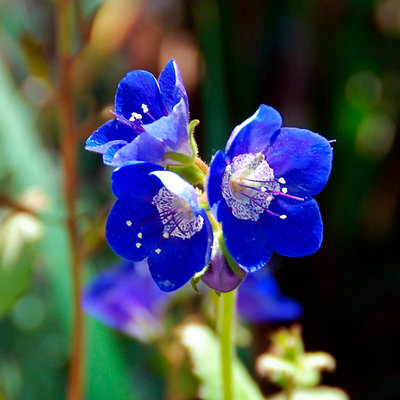
Pete Veilleux, East Bay Wilds
Parry’s Phacelia(
Phacelia parryi)
Native to Arizona and California
Native range: Coast, desert, inland and mountain
Where it will grow: Hardy to 0 degrees Fahrenheit (USDA zones 7 to 10)
Whimsical blue-violet to purple flowers make this phacelia a blue lover’s delight. Sometimes
P. parryi has an arrangement of five white spots or a pale coloration in the throat. Growing to only 1 foot to 2 feet tall and wide, this phacelia is an alluring accent in a rock garden.
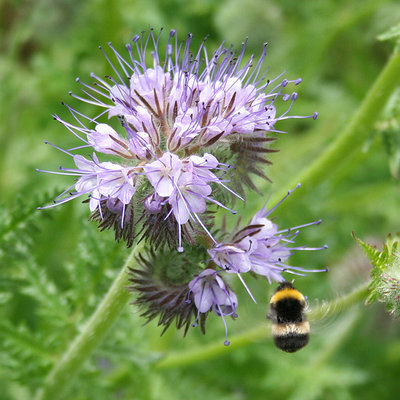 Tansy Leaf Phacelia
Tansy Leaf Phacelia(
Phacelia tanacetifolia)
Native to Arizona, California, Colorado, Kansas, Nevada and Oregon
Native range: Coast, desert, inland and mountain
Where it will grow: Hardy to -40 degrees Fahrenheit (USDA zones 3 to 10)
P. tanacetifolia does well in both full sun and light shade. As one of the tallest annuals — up to 4 feet tall — and the most widespread phacelia,
P. tanacetifolia is so robust and has such high-quality nectar and pollen that it is used as an agricultural cover crop to attract pollinators. Because of its appealing caterpillar-like coils and the large numbers of pollinators who feed on it, I ensure that there’s always space for
P. tanacetifolia in my home garden.
Photo by Alexandre DulaunoyMore: Browse plants native to other regions of the U.S.
How to Design a Garden for Native Bees





